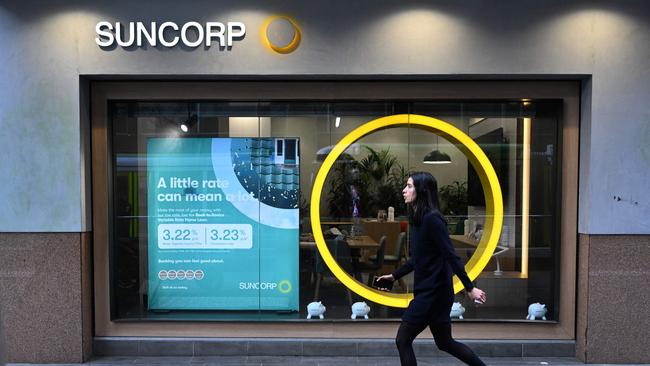ANZ to use CBA playbook in $4.9bn buyout
ANZ has been meticulous in building a case to win over the ACCC, taking nearly three months to submit a formal application for the deal.
ANZ is to submit its long-awaited pitch to acquire Suncorp Bank to the nation’s competition regulator within weeks as it seeks approval for the $4.9bn deal.
The banking major has been meticulous in building a case to win over the Australian Competition & Consumer Commission, taking nearly three months to submit a formal application for the deal.
A draft submission, or consultation document, will be delivered to the regulator before the end of October. The formal lodgement of ANZ’s submission is likely to follow in November, which then kicks off the ACCC’s investigation of the deal.
Melbourne-based ANZ unveiled the planned Suncorp buyout in July as part of efforts to build market share in home lending and business loans in Queensland.
The deal comes amid a backdrop of diminished competition, where major banks have been cutting branches across the country and pushing the full impact of the Reserve Bank interest rate hikes onto borrowers.
But a new ACCC document released under freedom of information rules is expected to bolster ANZ’s arguments to support the Suncorp deal.

The ACCC’s internal assessment of the Commonwealth Bank’s 2008 acquisition of Bankwest during the depths of the global financial crisis has laid the groundwork for a major bank to move on a regional offshoot.
Significantly, the 2008 competition assessment also concluded that savings accounts, credit cards and home loans competed on a national level, rather than state-based pricing. This also applied to small to mid-sized business banking products and agribusiness lending. It’s this national view that will underpin ANZ’s approach in seeking approval for the deal.
“The ACCC formed the view that the proposed (Bankwest) acquisition would be unlikely to result in a substantial lessening of competition in any of the relevant markets,” the newly released assessment of the deal reads.
That conclusion was formed even though Bankwest was considered at the time by the ACCC to be a “particularly vigorous competitor”. The document gave approval even as CBA stood to double its share of WA’s deposit market to 46 per cent and nearly double its share of branches across the state to 25 per cent. At the time it stood to deliver CBA about one in three of the state’s ATM fleet.
“The ACCC considered whether CBA would be likely to increase prices in Western Australia above the national price,” it reads.
“Despite what will be a more concentrated market in Western Australia than in other states post-acquisition, three significant competitors will remain for transaction accounts that would be likely to constrain CBA’s ability and incentive to significantly and sustainably increase prices.” The agency cited ANZ, National Australia Bank and Westpac as competitors.
The ACCC, chaired at the time by Graeme Samuel, was cut out of the normal approval process during the lightning Commonwealth Bank acquisition, which had largely been co-ordinated through bank regulator APRA, Treasury and the Reserve Bank. However, given public interest in the transaction at the time, it pushed ahead with a competition assessment.
Bankwest’s parent – the then UK banking major HBOS – was suffering from a funding squeeze following its global expansion and undertook a fire sale of its Australian offshoot. HBOS had put itself up for sale, with British lender Lloyds in the process of absorbing the failing UK bank.
CBA paid just $2.1bn for Bankwest, a deal at the time that was considered a bargain and was priced at 0.8 times the book value of the banking business. The ANZ move on Suncorp is being pitched at equal to book value.
The ACCC recently said it would commence a review of the Suncorp buyout when it received an application for merger authorisation from ANZ.
The competition regulator can green light the deal on two measures – it would not substantially reduce competition, or the benefit would outweigh any detriment for the public.
Final approval for the takeover sits with Treasurer Jim Chalmers, whose electorate of Rankin is in Brisbane’s southwestern suburbs. He has previously said he would wait for the advice of the ACCC on the deal.

Suncorp chief executive Steve Johnston has said the sale of the bank made sense as it allowed it to focus on its dominant general insurance business, which includes brands such as AAMI and GIO.
In terms of scale, Suncorp would lift ANZ’s share of the national lending market from 13.5 per cent to a little over 15.4 per cent, and it will remain the fourth-biggest bank.
ANZ chairman Paul O’Sullivan last month said the Suncorp acquisition fitted squarely into ANZ’s tech strategy, allowing it to roll out its digital investments to Suncorp’s customers.
“This (acquisition) gives us a step-up in share in the Queensland market, where we’ve been under-represented historically. And if you really believe the conviction that we are building a technology base, that gives us a much lower cost to serve customers,” Mr O’Sullivan said.
ANZ has argued it can offer Suncorp’s business customers more sophisticated products, while helping some advanced exports. It has already undertaken a $3.5bn capital raising to help fund the deal.
The bank is taking a cautious approach to integrating Suncorp, as it has not factored in any cost savings in the first three years following the buyout.






To join the conversation, please log in. Don't have an account? Register
Join the conversation, you are commenting as Logout